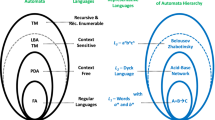Abstract
As interpreted by Pattee, von Neumann’s Theory of Self-Reproducing Automata has proved to be a useful tool for understanding some of the difficulties and paradoxes of molecular biosemiotics. But is its utility limited to molecular systems or is it more generally applicable within biosemiotics? One way of answering that question is to look at the Theory as a model for one particular high-level biosemiotic activity, human language. If the model is not useful for language, then it certainly cannot be generally useful to biosemiotics. Beginning with the Universal Turing Machine and continuing with von Neumann’s Theory and Pattee’s interpretation, the properties of universality, programmability, underspecification, complementarity of description/construction, and open-ended evolutionary potential are shown to be usefully applicable to language, thus opening a new line of inquiry in biosemiotics.
Similar content being viewed by others
References
Barbieri, M. (2009). A short history of biosemiotics. Biosemiotics, 2, 221–245.
Chomsky, N. (1965). Aspects of the theory of syntax. Cambridge: MIT Press.
Evans, N., & Levinson, S. (2009). The myth of language universals: Language diversity and its importance for cognitive science. The Behavioral and Brain Sciences, 32, 429–492.
Glimm, J., Impagliazzo, J., Singer, I. M., eds. (1990). The legacy of John von Neumann. Proceedings of symposia in pure mathematics, vol. 50. American Mathematical Society
Goldstine, H. H. (1972). The computer from Pascal to von Neumann. Princeton: Princeton University Press.
Herken, R. (Ed.). (1994). The Universal Turing Machine: A half-century survey. Vienna: Springer.
Hurford, J. (1990). Nativist and functional explanations in language acquisition. In I. M. Roca (Ed.), Logical issues in language acquisition (pp. 85–136). Dordrecht: Foris.
McMullin, B. (2000). John von Neumann and the evolutionary growth of complexity: Looking backward, looking forward. Artifical Life, 6, 347–361.
Pattee, H. H. (1969). How does a molecule become a message? Developmental Biology Supplement, 3, 1–16.
Pattee, H. H. (1982). Cell psychology: An evolutionary approach to the symbol-matter problem. Cognition and Brain Theory, 4, 325–341.
Pattee, H. H. (2001). The physics of symbols: Bridging the epistemic cut. Biosystems, 60, 5–21.
Pattee, H. H. (2005). The physics and metaphysics of biosemiotics. Journal of Biosemiotics, 1, 281–301.
Pattee, H. H. (2007). The necessity of biosemiotics: Matter-symbol complementarity. In M. Barbieri (Ed.), Introduction to biosemiotics (pp. 115–132). Dordrecht: Springer.
Pattee, H. H. (2008). Physical and functional conditions for symbols, codes, and languages. Biosemiotics, 1, 147–168.
Pattee, H. H. (2009). Response to Jon Umerez’s paper: “Where does Pattee’s ‘how does a molecule become a message?’ belong in the history of biosemiotics?”. Biosemiotics, 2, 291–302.
Turing, A. M. (1936). On computable numbers, with an application to the entscheidungsproblem. Proceedings of the London Mathematical Society, 42, 230–265.
Umerez, J. (2009). Where does Pattee’s “how does a molecule become a message?” belong in the history of biosemiotics? Biosemiotics, 2, 269–290.
Von Neumann, J. (1961). General and logical theory of automata. In A. H. Taub (Ed.), John von Neumann: Collected works, vol. V (pp. 288–326). Oxford: Pergamon.
Von Neumann, J. (1966). In A. W. Burks (Ed.), Theory of self-reproducing automata. Urbana: University of Illinois Press.
Author information
Authors and Affiliations
Corresponding author
Rights and permissions
About this article
Cite this article
Waters, D.P. Von Neumann’s Theory of Self-Reproducing Automata: A Useful Framework for Biosemiotics?. Biosemiotics 5, 5–15 (2012). https://doi.org/10.1007/s12304-011-9127-z
Received:
Accepted:
Published:
Issue Date:
DOI: https://doi.org/10.1007/s12304-011-9127-z




